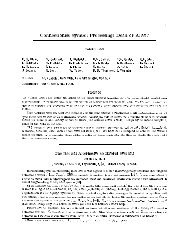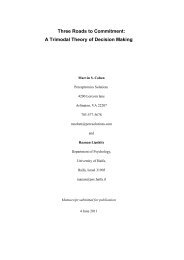Three Roads to Commitment: A Trimodal Theory of Decision Making
Three Roads to Commitment: A Trimodal Theory of Decision Making
Three Roads to Commitment: A Trimodal Theory of Decision Making
You also want an ePaper? Increase the reach of your titles
YUMPU automatically turns print PDFs into web optimized ePapers that Google loves.
<strong>Three</strong> <strong>Roads</strong> <strong>to</strong> <strong>Commitment</strong>: A <strong>Trimodal</strong> <strong>Theory</strong> <strong>of</strong> <strong>Decision</strong> <strong>Making</strong> 37<br />
possible outcomes <strong>of</strong> each option How likely and how desirable is each outcome) and lack known possible<br />
answers. Bot<strong>to</strong>m-up search falls back on non-specific questions (e.g., Why are you doing that What happens<br />
next...), reflecting open-ended search for information, examples, advice, or solutions, or ground-level acquisition <strong>of</strong><br />
basic concepts, facts, and practices, without advance knowledge <strong>of</strong> where the process is going. Top-down analytic<br />
approaches are more efficient than bot<strong>to</strong>m-up methods if their assumptions are satisfied, because they leverage<br />
abstract theoretical knowledge, rules, frameworks, or techniques <strong>to</strong> constrain search and build understanding <strong>of</strong> an<br />
unfamiliar situation.<br />
Objective affordance for commitment, i.e., action uncertainty, is determined by the efficiency <strong>of</strong> the methods<br />
afforded <strong>to</strong> a particular decision maker in a particular decision setting. What determines a method’s efficiency – i.e.,<br />
the cognitive effort it requires <strong>to</strong> answer the primary question associated with a decision mode – is the relative role<br />
<strong>of</strong> matching versus search and reassessment at a second-order level, i.e., in the determination <strong>of</strong> process. This varies,<br />
as shown in Figure 5, from adaptive intuition (questions primed by matching and immediately answered; no search),<br />
<strong>to</strong> adaptive deliberation (process and possible answers primed by matching; limited search), <strong>to</strong> <strong>to</strong>p-down analysis<br />
(process provided by matching, but no advance knowledge <strong>of</strong> possible answers; exhaustive search <strong>of</strong> possibilities),<br />
<strong>to</strong> bot<strong>to</strong>m-up search (matching provides little constraint; search space must be created while it is explored).<br />
A Modes x Methods Taxonomy <strong>of</strong> <strong>Decision</strong> Strategies<br />
<strong>Decision</strong> strategies can now be represented in more detail, as sets <strong>of</strong> paths through the more complex<br />
framework depicted in Figure 5 – comprising primary questions and iterated cycles <strong>of</strong> posing and answering<br />
secondary questions, by methods that respond <strong>to</strong> different types <strong>of</strong> uncertainty. Both strong and weak methods may<br />
apply in any decision mode. Table 2 cites examples <strong>of</strong> research paradigms and strategies corresponding <strong>to</strong> each<br />
combination <strong>of</strong> decision mode (matching, choice, and reassessment) and uncertainty handling method (Strong,<br />
Weak), in both fast and slow versions. For example, with strong intuitive methods, the primed process may be<br />
matching (e.g., committing <strong>to</strong> the action recognized as appropriate in the situation; Klein, 1993), choice (e.g., an<br />
intuitive strategy <strong>of</strong> taking the option recognized as most familiar; Gigerenzer & Selten, 2001), or reassessment<br />
(e.g., intuitively deciding <strong>to</strong> abort take<strong>of</strong>f based on a recognized pattern <strong>of</strong> cues; Orasanu & Fischer, 1997)..<br />
Similarly, with strong deliberative methods, the primed process may be matching (e.g., taking the action associated<br />
with the most plausible s<strong>to</strong>ry; Cohen et al., 1996), choice (e.g., showing that one option dominates all the others;<br />
Montgomery, 1993), or reassessment (e.g., mentally simulating implementation <strong>of</strong> a course <strong>of</strong> action; Klein, 1993).<br />
Top down weak methods include legal, ideological, and scientific reasoning for matching, decision analysis for




